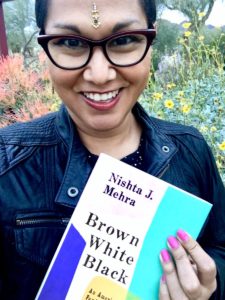HANNAH JOHNSON
Special to The Leader
Nishta Mehra, a wife, author and first generation daughter of Indian immigrants has a goal to promote dialogue across differences of culture identity through her book, “Brown, White, Black.”
Born and raised in Memphis, T.N., Mehra is an alum of St. Mary’s Episcopal school and has a B.A. in religious studies from Rice University.
Mehra came to Fredonia Thursday afternoon to tell her story she described as, “Navigating who I am without the help of my parents who are immigrants and grew up in a different culture.”
The room was filled with Fredonia students and townies eager to hear Mehra’s story.
“My book dives into how race, religion and sexuality play into giving yourself an identity,” she said.
Growing up, Mehra tried to blend in with everyone else — she didn’t identify with her Indian culture. Instead she avoided it.

“I distanced myself from other Indians for fear I wouldn’t live up to the stereotypes, like I wouldn’t be Indian enough. I avoided clubs, friendships and temple visits,” she said.
This all changed after the tragic loss of her father.
“Grief comes with a change in appearance,” Mehra said. “I did what my dad always wanted me to do. I grew my hair out long and got my ears pierced.”
She also honored her father by cooking his favorite Indian dishes.
“It was something to do while I was grieving. In my small grad-school apartment in Arizona, I was step-by-step learning dishes while on the phone with my mother telling me measurements.”
Soon came the Bindi.
A Bindi is a colored dot worn on the forehead. Bindu is considered the point at which creation begins in Hindi culture.
“At first it was something I took on and off, something I felt prideful and embarrassed about at the same time,” Mehra said.“I felt like wearing the Bindi would be too much on my identity, like I would immediately be identified to others in my tribe. Now I feel naked without it. Even just to [go to] the gym, I need it. I don’t even recognize myself without it anymore. It has become part of my identity.”
Another major change for Mehra was adding being queer into her identity.
“I had never heard of another brown gay woman, so I decided to leave my Indian identity behind for a bit to explore my queer identity,” she said.
Soon Mehra met her wife, Jill, who she is now married to with their child, Shiv, who is non-bianary.
“It is fascinating watching my Shiv try to find her identity. Which culture out of Jill’s, mine or her own will she be more drawn towards? We try to guide Shiv, but let her make her own decisions,” Mehra said.
Fredonia students jumped at the chance to ask Mehra questions and applaud her for her amazing story.
With such an interesting background described as, “Living life on a seesaw,” she left a positive impact on this campus by making listeners think — what are our identities?
